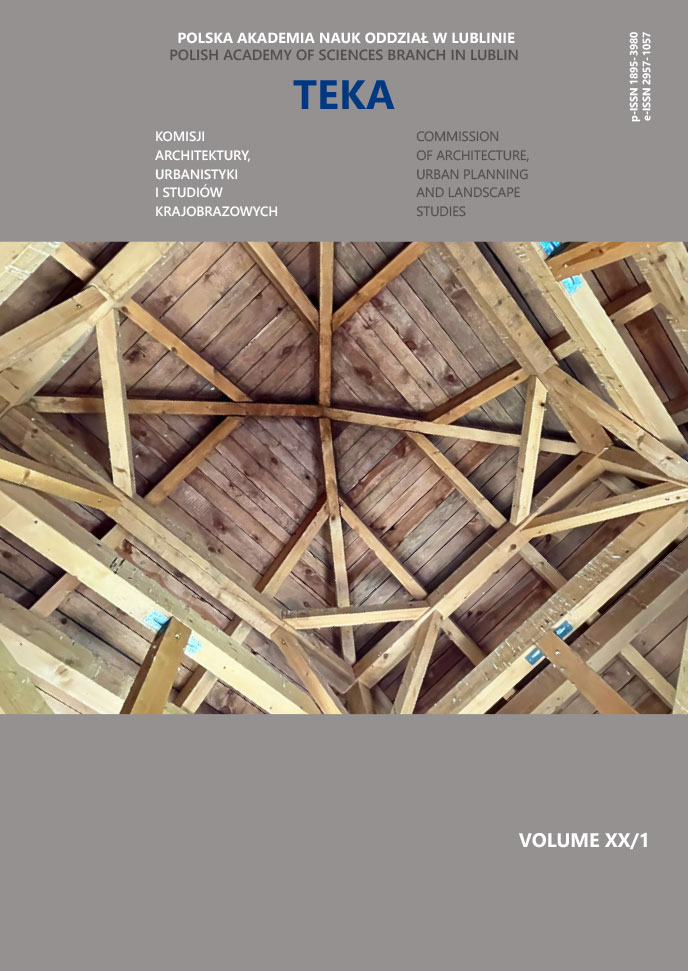Świadomość dzieci o osobach z niepełnosprawnościami i ich barierach
##plugins.themes.bootstrap3.article.sidebar##
Open full text
Numer Tom 20 Nr 1 (2024)
-
Problematyka przystosowania sal wykładowych Politechniki Lubelskiej do współczesnych potrzeb użytkowych
Bartłomiej Kwiatkowski, Kostiantyn Pinkovskyi, Pavlo Lozovskyi7-18
-
Zielona rewitalizacja Placu NZS w Białymstoku
Andrzej Tokajuk19-27
-
Podstawowe elementy składowe dynamicznego modelu we wzornictwie przemysłowym
Ihor Yurchenko28-35
-
Degradacja przestrzeni publicznych na przykładzie rewitalizacji wybranych placów i rynków w Wielkopolsce
Karol Tomczak, Paweł Szumigała36-49
-
Dostosowanie lokali usługowych dla rodzin z dziećmi w kontekście dostępności i inkluzywności
Dariia Kryshnivska, Małgorzata Kozak50-59
-
Architektura wybranych dziennych centrów psychiatrycznych – studium przypadku
Rafał Strojny, Weronika Gospodarek60-68
-
Dendrochronologia i akceleratorowa mas‑spektrometria (AMS) datowania za pomocą C‑14: nowe i potężne połączenie
Myron O. Stachiw, William A. Flynt69-79
-
Świadomość dzieci o osobach z niepełnosprawnościami i ich barierach
Kornelia Szadura, Piotr Gleń80-87
Archiwum
-
Tom 20 Nr 3
2024-12-27 7
-
Tom 20 Nr 2
2024-12-27 7
-
Tom 20 Nr 1
2024-12-27 8
-
Tom 19 Nr 2
2023-12-29 11
-
Tom 19 Nr 1
2023-12-19 13
-
Tom 18 Nr 4
2022-12-30 5
-
Tom 18 Nr 3
2022-12-27 5
-
Tom 18 Nr 2
2022-12-27 5
-
Tom 18 Nr 1
2022-12-27 4
-
Tom 17 Nr 4
2021-12-30 11
-
Tom 17 Nr 3
2021-12-30 9
-
Tom 17 Nr 2
2021-12-30 8
-
Tom 17 Nr 1
2021-12-30 8
-
Tom 16 Nr 4
2020-12-30 11
-
Tom 16 Nr 3
2020-09-30 10
-
Tom 16 Nr 2
2020-06-30 11
-
Tom 16 Nr 1
2020-03-31 10
##plugins.themes.bootstrap3.article.main##
DOI
Authors
Abstrakt
W Polsce idea projektowania uniwersalnego, choć zyskała popularność w latach 90. XX wieku, była już wcześniej związana z prawami człowieka i urbanistyką. Obecnie stanowi standard i wymóg prawny w wielu aspektach projektowych. Tematyka ta dotyka również szeroko pojętego zagadnienia Zrównoważonego Rozwoju (SDG 11), które promują tworzenie miast bez barier i inkluzywnych przestrzeni dla osób z niepełnosprawnościami. Projektowanie uniwersalne, oparte na różnorodności i potrzebach wszystkich użytkowników, ma na celu eliminację przeszkód technicznych, społecznych i psychologicznych, które ograniczają samodzielność i uczestnictwo w życiu społecznym. Istotnym wyzwaniem pozostaje podnoszenie świadomości społecznej oraz uczenie empatii, co prowadzi do naturalnego projektowania przestrzeni dostępnych dla każdego. Pomocne mogą stać się warsztaty dla dzieci, które wprowadzą świadomość o osobach niepełnosprawnych i ich barierach, jak i również pokażą dotychczasową świadomość na podany temat. Wyniki ukazują, że dzieci miały styczność z osobami niepełnosprawnymi poruszającymi się na wózku i potrafią wskazać bariery architektoniczne dla tych osób, lecz mniejsza jest świadomość o niepełnosprawności wzrokowej.
Słowa kluczowe:
Bibliografia
„O co tyle szumu? Projektowanie uniwersalne”, Formy. Adres: https://formy.xyz/artykul/o-co-tyle-szumu-projektowanie-uniwersalne/ [Dostęp: 17 grudzień 2024].
Bohun A., „Teachers’ Knowledge and Use of Universal Design Principles in the EFL classroom”, (paź. 2022).
Kamińska D. et al., „Universal design and empathic design for engineers”, Medycyna Pracy. Workers’ Health and Safety, t. 74, nr 3, (wrz. 2023), s. 211−225. https://doi.org/10.13075/mp.5893.01388. DOI: https://doi.org/10.13075/mp.5893.01388
Kowalski K., Projektowanie bez barier – wytyczne, I wyd. Warszawa: Stowarzyszenie Przyjaciół Integracji, 2010.
Szalewicz K., „Projektowanie uniwersalne - zagospodarowanie przestrzeni dla osób niepełnosprawnych”, Niepełnosprawność, t. 2018, nr Nr 30 (2018), (wrz. 2018), s. 401−419. https://doi.org/10.4467/25439561.NP.18.038.9876. DOI: https://doi.org/10.4467/25439561.NP.18.038.9876
Gleń P. i Riekste A., „Teoria i praktyka w nauczaniu projektowania uniwersalnego”, Teka Komisji Architektury, Urbanistyki i Studiów Krajobrazowych, t. 19, nr 1, (sie. 2023), s. 87−96. https://doi.org/10.35784/teka.3600. DOI: https://doi.org/10.35784/teka.3600
Adaszyńska E., „Projektowanie uniwersalne - dostępność i uczestnictwo dla wszystkich”, (2017).
Jówko E., „Projektowanie uniwersalne. innowacja w kształceniu studentów Uniwersytetu Przyrodniczo-Humanistycznego w Siedlcach.”, Student Niepełnosprawny. Szkice i Rozprawy, nr 22(15), (grudz. 2022). https://doi.org/10.34739/sn.2022.22.06. DOI: https://doi.org/10.34739/sn.2022.22.06
Pers M., „Niepełnosprawni a dostępność przestrzeni wszelkich typów. Cz. 2, Architektura kontrolowana, budowa ośrodków dla niepełnosprawnych mentalnie na przykładzie USA”, Czasopismo Techniczne. Architektura, nr R. 96, z. 1-A, (1999), s. 58−65.
Kuryłowicz E., Projektowanie uniwersalne: udostępnianie otoczenia osobom niepełnosprawnym. Centrum Badawczo-Rozwojowe Rehabilitacji Osób Niepełnosprawnych, 1996.
##plugins.themes.bootstrap3.article.details##
Abstract views: 141



